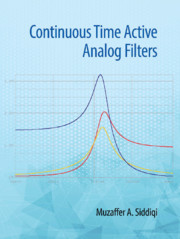Book contents
- Frontmatter
- Dedication
- Contents
- Preface
- Acknowledgments
- 1 Analog Filter: Concepts
- 2 First-and Second-order Filters
- 3 Magnitude Approximations
- 4 Delay: Approximation and Optimization
- 5 Frequency and Impedance Transformations
- 6 Sensitivity of Active Networks
- 7 Single Amplifier Second-order Filters
- 8 Multi Amplifier Second-order Filter Sections
- 9 Direct Form Synthesis: Element Substitution and Operational Simulation
- 10 Cascade Approach: Optimization and Tuning
- 11 Amplification and Filtering in Biomedical Applications
- 12 Audio Signal Processing and Anti-aliasing Filters
- 13 Follow the Leader Feedback Filters
- 14 Switched Capacitor Circuits
- 15 Operational Transconductance Amplifier-C Filters
- 16 Current Conveyors and CDTA (Current Differencing Transconductance Amplifiers) Based Filters
- 17 Active R and Active C Filters
- Index
6 - Sensitivity of Active Networks
Published online by Cambridge University Press: 24 December 2019
- Frontmatter
- Dedication
- Contents
- Preface
- Acknowledgments
- 1 Analog Filter: Concepts
- 2 First-and Second-order Filters
- 3 Magnitude Approximations
- 4 Delay: Approximation and Optimization
- 5 Frequency and Impedance Transformations
- 6 Sensitivity of Active Networks
- 7 Single Amplifier Second-order Filters
- 8 Multi Amplifier Second-order Filter Sections
- 9 Direct Form Synthesis: Element Substitution and Operational Simulation
- 10 Cascade Approach: Optimization and Tuning
- 11 Amplification and Filtering in Biomedical Applications
- 12 Audio Signal Processing and Anti-aliasing Filters
- 13 Follow the Leader Feedback Filters
- 14 Switched Capacitor Circuits
- 15 Operational Transconductance Amplifier-C Filters
- 16 Current Conveyors and CDTA (Current Differencing Transconductance Amplifiers) Based Filters
- 17 Active R and Active C Filters
- Index
Summary
Introduction
In the previous chapters, comparatively simple methods have been discussed for the realization of active OA (operational amplifier) RC filters. Many more methods of filter synthesis will be discussed later, providing many more filter circuit configurations. Among this large number of available circuits, the choice of a ‘best’ filter circuit may depend on the specific user's requirements. However, every application ideally requires a practical filter for which performance parameters, like ωo (center frequency or cut-off frequency) and quality (pole-Q), are needed exactly as designed, and expected to remain invariant with use in varying environment. However, in practice, the user is satisfied if the parameters remain within such limits that do not make the filter impractical. Though there are different reasons during fabrication which cause deviations in the performance parameters, there is one factor which is common to all circuits at design stage. This factor can be termed as the first consideration in connection with these deviations. It is studied under sensitivity and is due to the following reasons.
i. Design of a filter circuit assumes active and passive elements to be ideal, whereas in every practical fabrication process, the nominal value of the passive element has statistical variations around its mean value. In general, sophisticated, higher level fabrication processes reduce the parameter variations; elements are said to have smaller tolerance. However, for such advanced processes, filter fabrication cost will go up.
ii. The values of both active and passive components change with change in operating conditions like change in temperature, humidity and supply voltage. Some chemical changes due to aging also affect the element values.
Whatever be the reason for the difference between the practical element value(s) and the original design value(s), performance of the filter gets affected, and it is said that the filter performance parameters are sensitive to the elements used. Sensitivity studies of filter circuit parameters provide the information whether a particular circuit will meet the given specifications under likely tolerances of the elements or not. The studies also help in establishing filter stability and hence the filter's utility in the long term.
- Type
- Chapter
- Information
- Continuous Time Active Analog Filters , pp. 149 - 169Publisher: Cambridge University PressPrint publication year: 2020



